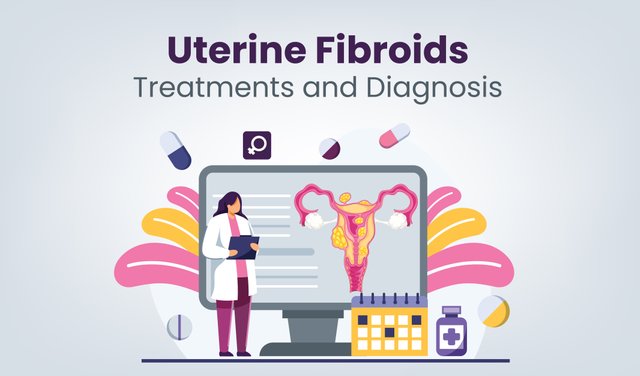
Uterine fibroids are noncancerous uterine growths that commonly arise during pregnancy. Uterine fibroids, also known as leiomyomas or myomas, aren't linked to an elevated risk of uterine cancer and usually never develop into cancer.
Fibroids range in size from tiny seedlings that are invisible to enormous masses that deform and expand the uterus. You might have only one fibroid or many. Multiple fibroids can cause the uterus to enlarge to the point where it reaches the rib cage, causing weight gain and Uterine fibroids to affect many women at some point in their life. However, because uterine fibroids seldom cause symptoms, you may be unaware that you have them. During a pelvic exam or a prenatal ultrasound, your doctor may uncover fibroids by chance.
Symptoms
The Best Gynecologist in Nashik states that many women with fibroids have no symptoms. The location, size, and quantity of fibroids might affect symptoms in persons who have them.
The following are the symptoms of uterine fibroids in women:
- Menstrual bleeding is severe.
- Menstrual cycles that last more than a week
- Pelvic discomfort or pressure
- Urinating often
- Having trouble emptying the bladder
- Constipation
- Leg aches or backache
- When a fibroid outgrows its blood supply and begins to die, it can cause severe discomfort.
Causes
Uterine fibroids are unknown to doctors, however, studies and clinical experience indicate the following factors:
• Many fibroids have gene alterations that aren't found in uterine muscle cells.
• Estrogen and progesterone, two hormones that boost uterine lining development in preparation for pregnancy throughout each menstrual cycle, appear to increase fibroids growth.
• Compared to uterine muscle cells, fibroids have higher estrogen and progesterone receptors. Due to a decrease in hormone synthesis, fibroids tend to diminish after menopause.
• Other variables that contribute to growth Insulin-like growth factors, for example, can influence fibroid development.
• Matrix outside of cells (ECM). The substance that holds cells together, like mortar between bricks, is called ECM. ECM stands for "electronic communications chevalier." In fibroids, ECM levels rise, making them fibrous. ECM also stores growth factors and influences cell biology.
• Uterine fibroids are thought to arise from myometrium (a stem cell in the uterus' smooth muscle tissue). A single cell divides several times, eventually forming a solid, rubbery mass that is separate from surrounding tissue.
• Uterine fibroids have a variety of development patterns: they might grow slowly or quickly, or they can stay the same size. Some fibroids have growth spikes, while others decrease on their own.
• As the uterus returns to its normal size after pregnancy, many fibroids that were present during pregnancy diminish or vanish.
Treatments
Uterine fibroids affect the majority of women at some point in their lives states the physicians from the Best Gynecology Hospital in Nashik, yet they typically go unnoticed. Fibroids in the uterus are noncancerous tissue lumps that form there. These fibroids might be as little as a peanut or as huge as a giant watermelon. Fibroids can form in clusters or as a single growth. Individually, they grow at different rates.
Fibroids are divided into four categories based on where they grow
• Submucosal fibroids: Fibroids found in the uterus' muscular layer (myometrium).
• Intramural fibroids are fibroids that develop within the uterus' inner muscle wall.
• Fibroids found outside the uterus or on the external uterine lining are known as subserosal fibroids.
• When they extend far into the uterus these tumors are known as pedunculated fibroids.
Uterine fibroids can thicken the uterine lining unnaturally or cause structural abnormalities in the uterus and cervix, affecting sperm motility, sperm count entering the uterus, obstructing the fallopian tubes, and even causing problems with embryo implantation, resulting in reproductive problems or infertility. Submucosal fibroids commonly obstruct fertility.
Uterine fibroids can be treated with a variety of fibroids therapies.
• Medications for fibroid symptoms include GnRH agonists, which suppress the synthesis of estrogen and progesterone, as well as progestin-releasing intrauterine devices (IUDs) and other anti-inflammatory treatments.
• Non-invasive surgical techniques, such as focused ultrasound surgery (FUS)
• Fibroids can be removed using minimally invasive surgical treatments including embolization, laparoscopy, hysteroscopy, and ablation.
Connect with our professional panel of endometriosis doctors for specialized care and treatment.
If you're having problems conceiving because of fibroids, see a fertility doctor.
Diagnosis
During a normal pelvic exam, uterine fibroids are routinely discovered. Your doctor may notice changes in the shape of your uterus, which could indicate the presence of fibroids.
If you have uterine fibroids symptoms, your doctor may request the following tests:
Ultrasound. Your doctor may order an ultrasound if further confirmation is required. It takes a picture of your uterus with sound waves to confirm the diagnosis and map.
Laboratory tests. If you experience unusual monthly bleeding, your doctor may request additional testing to rule out other possibilities. A complete blood count (CBC) may be performed to see if you have anemia from persistent blood loss, as well as additional blood tests to rule out bleeding
Conclusion
Uterine fibroid is a typical cause of many bleeding and pain symptoms in women of reproductive age, which can have a severe impact on several parts of a woman's life. Conclusions. Uterine fibroid is a typical cause of many bleeding and pain symptoms in women of reproductive age, which can have a severe impact on several parts of a woman's life.